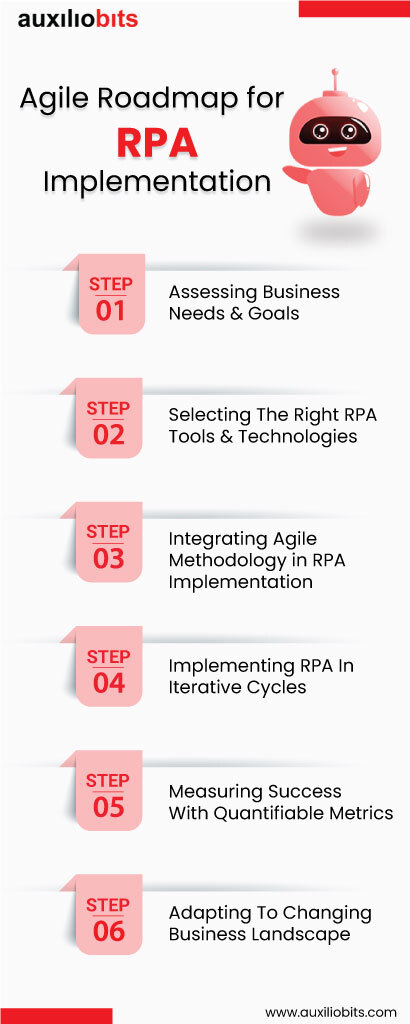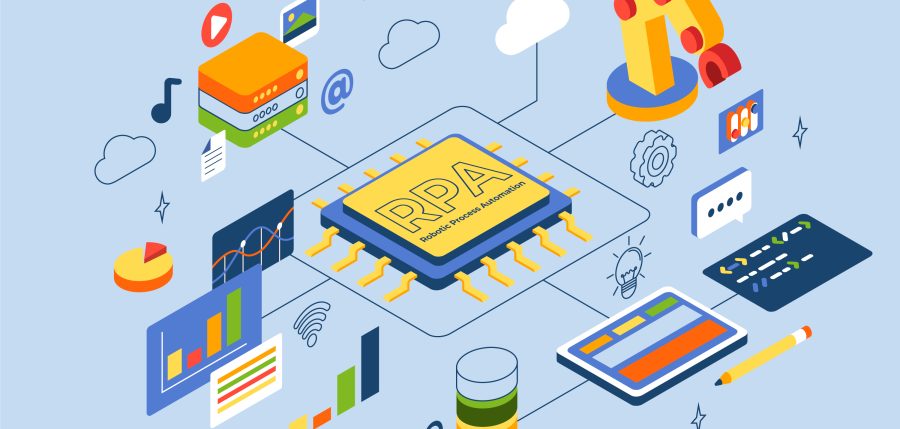
Key takeways
- Robotic Process Automation (RPA) has emerged as a powerful tool that promises to transform businesses by automating repetitive tasks & streamlining workflows.
- Agile brings flexibility, adaptability & rapid iteration to RPA deployment that allows businesses to respond swiftly to changing requirements.
- An agile roadmap for RPA deployment makes it resilient and sustainable.
- By combining the transformative power of RPA with the agility of Agile methodologies, businesses can navigate complexities, adapt to change, and achieve sustainable growth.
Staying competitive requires constant innovation & efficiency in today’s rapidly evolving business landscape. Robotic Process Automation (RPA) has emerged as a powerful tool that promises to transform businesses by automating repetitive tasks & streamlining workflows. But, implementing RPA successfully requires a strategic approach & that’s where an Agile RPA roadmap comes into play.
Here, we’ll explain each step of creating an agile RPA roadmap tailored to your business needs, ensuring a successful and adaptive RPA implementation.
Power Of RPA In Business Transformation
Robotic Process Automation (RPA) involves using software robots or “bots” to perform rule-based, repetitive tasks that were traditionally carried out by humans. RPA offers umpteen benefits that include increased operational efficiency, reduced errors & enhanced scalability. A recent study by McKinsey & Company estimated that by 2030, accelerated adoption of artificial intelligence could result in the automation of about 30% of hours worked by Americans which leads to significant cost savings & resource optimization. [Fox Business]
Why An Agile Approach Is Vital For RPA Implementation?
Agile methodologies, originally popular in software development, are now being embraced in several business contexts, including RPA implementation. Agile brings flexibility, adaptability & rapid iteration to projects that allow businesses to respond swiftly to changing requirements. A study indicates companies that embrace Agile are 2.5 times more likely to be top performers in their industry & achieve a 30% higher return on investment. Incorporating Agile principles into your RPA roadmap ensures that your implementation remains aligned with your business goals & evolving needs. [Slide Team]
Agile Roadmap for Digital Transformation
Step 1: Assessing Business Needs & Goals
- Identifying Process Bottlenecks & Inefficiencies
Before diving into RPA implementation, conduct a thorough assessment of your existing processes. Identify pain points, bottlenecks, and tasks that are time-consuming or error-prone. For instance, a recent study found that 22% of an employee’s time is spent on repetitive tasks that drain time and resources. By identifying and rectifying these bottlenecks, you’re not only saving precious time but also unlocking the potential for remarkable cost savings. [Impact , Kofax]
- Defining Clear Objectives & Key Performance Indicators (KPIs)
Set clear objectives for your RPA initiative. Define specific goals, such as reducing processing time by a certain percentage or minimizing error rates. Assign Key Performance Indicators (KPIs) that will help you measure the success of your RPA implementation. A study has shown that organizations that set clear objectives and KPIs suffer 33% fewer project failures. These figures underscore the importance of this step in your journey toward RPA excellence. [CIO]

Step 2: Selecting The Right RPA Tools & Technologies
- Evaluating Top RPA Platforms
The RPA landscape is populated with various platforms, each offering distinct features and capabilities. Perform a comprehensive evaluation of the top RPA platforms available in the market. In the bustling RPA market, where options abound, Conducting thorough research is paramount. For instance, UiPath, a frontrunner in the RPA realm, boasts an astounding customer satisfaction rate of 94%. This data underscores the importance of choosing a platform that not only aligns with your needs but also demonstrates a proven track record of success. [UiPath]
- Comparing Features, Scalability & Integration Capabilities
Compare the features of different RPA tools to ensure they align with your business needs. Look for capabilities like workflow automation, cognitive automation, and artificial intelligence integration. Scalability is also crucial—your chosen platform should accommodate future expansion. Additionally, seamless integration with your existing software landscape is essential for a smooth and efficient implementation. A recent study found several organizations reported higher efficiency (86%), deeper insights into customers (67%), and improved customer service (57%) after implementing RPA. [UiPath]
Step 3: Integrating Agile Methodology in RPA Implementation
- Setting Up Sprints & Milestones
Adopt an Agile approach by dividing your implementation into sprints or iterative cycles. Each sprint focuses on automating specific processes or functionalities. Set achievable milestones for each sprint, ensuring steady progress. A study indicates that Agile projects are 28% more successful than traditional projects. By adopting this approach, you not only ensure steady progress but also facilitate the flexibility required for adaptive automation. [SciELO]
- Incorporating Feedback Loops For Continuous Improvement
Agile methodologies emphasize continuous improvement. Regularly solicit feedback from end-users and stakeholders to refine your automation processes. Address any issues or challenges that arise promptly. By incorporating feedback loops, you ensure that your RPA implementation evolves to meet changing business needs and remains aligned with your objectives. Research indicates that companies that consistently incorporate customer feedback ultimately increase customer retention. And, increasing customer retention by just 5% can lead to a 25-95% increase in profits. [GetFeedback]
Step 4: Implementing RPA In Iterative Cycles
- Pilot Testing & Validation
Before scaling up automation, conduct pilot testing to validate your RPA solutions in real-world scenarios. Pilot testing helps identify any unforeseen challenges and allows you to fine-tune your automation processes. For example, if you’re automating customer support ticket routing, pilot tests the solution with a subset of tickets to assess its accuracy and efficiency.
- Scaling Up Automation Gradually While Monitoring Performance
After successful pilot testing, gradually scale up automation across processes. Monitor the performance of your automated processes closely. Track metrics such as processing time, error rates, and user satisfaction. Scalability is a key benefit of RPA, and as you expand automation, ensure that the performance remains consistent and aligned with your goals. research shows that businesses that embrace a gradual approach to RPA implementation experience a cost reduction (59%), increased compliance (92%), improved quality/accuracy (90%), and enhanced productivity (86%). [LinkedIn]
Step 5: Measuring Success With Quantifiable Metrics
- Tracking Cost Savings, Time Reduction & Error Elimination
Quantify the impact of your RPA implementation by tracking tangible metrics. Measure cost savings resulting from reduced manual effort, decreased error rates, and optimized resource allocation. According to a report by McKinsey, implementing RPA can lead to a 30-50% reduction in processing time and a 25-50% reduction in operational costs. [LinkedIn]
- Demonstrating ROI To Stakeholders With Concrete Data
To showcase the success of your Agile RPA roadmap, compile data that demonstrate Return on Investment (ROI) to stakeholders. Present them with concrete evidence of cost savings, efficiency gains, and improved accuracy. This data-driven approach enhances credibility and justifies ongoing investments in RPA initiatives. McKinsey Digital reveals that integrating RPA into business processes can deliver a 30% to 200% increase in ROI within the first year. Additionally, the Institute of RPA predicts potential labor cost savings of 25% to 40% through RPA solutions. [Your Team India , McKinsey , Gartner]
Step 6: Adapting To Changing Business Landscape
- Embracing Flexibility
The business landscape is dynamic, and processes evolve over time. An Agile RPA roadmap embraces flexibility to accommodate process changes and new requirements. Whenever a change is introduced, assess its impact on your RPA implementation and adjust your roadmap accordingly. Agile methodologies enable you to respond swiftly to changes and maintain a competitive edge.
- Integrating AI & Cognitive Capabilities For Enhanced Automation
Artificial Intelligence (AI) and cognitive capabilities can amplify the benefits of RPA. AI-powered bots can handle more complex decision-making tasks and enable greater process automation. For instance, using natural language processing, bots can analyze & extract information from unstructured data sources, such as emails or documents. By integrating AI with RPA, you can achieve even higher levels of efficiency & automation. A report by McKinsey & Company found that automation has the potential to increase global productivity growth by 0.8% to 1.4% annually. [Market Splash]
An agile approach to RPA implementation makes the digital transformation journey of the business seamless. However, agile methodology is not restricted only to the implementation. An agile approach is the way ahead for sustainable growth.
Best Practices For Sustainable RPA Growth
Continuous Learning & Upskilling For RPA Team Members
The field of RPA is ever-evolving, and continuous learning is essential for sustained success. Encourage your RPA team members to upskill by attending training sessions, workshops, and industry events. Staying updated with the latest developments in RPA tools and technologies ensures that your team remains equipped to tackle new challenges. A study has shown that organizations that invest in upskilling recorded a 57% increase in sales and a 37% rise in gross profit per employee. [Schoox]
Leveraging Community Resources & Forums For Knowledge Sharing
RPA communities and forums provide valuable platforms for knowledge sharing and problem-solving. Encourage your RPA team to participate in these communities to exchange insights, best practices, and solutions to common challenges. Active engagement in these forums can enhance your team’s expertise and contribute to the success of your Agile RPA roadmap. Research reveals that knowledge sharing enhances productivity by 20-25%. [McKinsey]
Conclusion
The implementation of an Agile RPA roadmap is a strategic imperative in the modern business landscape. By combining the transformative power of RPA with the agility of Agile methodologies, businesses can navigate complexities, adapt to change, and achieve sustainable growth. As technology continues to evolve and industries become increasingly competitive, an Agile RPA roadmap serves as a beacon, guiding businesses toward resilience and success.
Creating a tailored Agile RPA roadmap that aligns with your business goals paves the way for a brighter and more automated future.
Have you started on the digital transformation journey for your business?
The professional team at Auxiliobits will make your journey seamless! We will help you select the best RPA tools for your business. We will help you integrate it into your existing systems by developing a customized agile RPA roadmap that fosters sustainable business growth!





